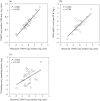Genome-wide screening of loci associated with drug resistance to 5-fluorouracil-based drugs
- PMID: 17425594
- PMCID: PMC11158905
- DOI: 10.1111/j.1349-7006.2007.00424.x
Genome-wide screening of loci associated with drug resistance to 5-fluorouracil-based drugs
Abstract
Resistance to chemotherapeutic agents represents the chief cause of mortality in cancer patients with advanced disease. Chromosomal aberration and altered gene expression are the main genetic mechanisms of tumor chemoresistance. In this study, we have established an algorithm to calculate DNA copy number using the Affymetrix 10K array, and performed a genome-wide correlation analysis between DNA copy number and antitumor activity against 5-fluorouracil (5-FU)-based drugs (S-1, tegafur + uracil [UFT], 5'-DFUR and capecitabine) to screen for loci influencing drug resistance using 27 human cancer xenografts. A correlation analysis confirmed that the single nucleotide polymorphism (SNP) showing significant associations with drug sensitivity were concentrated in some cytogenetic regions (18p, 17p13.2, 17p12, 11q14.1, 11q11 and 11p11.12), and we identified some genes that have been indicated their relations to drug sensitivity. Among these regions, 18p11.32 at the location of the thymidylate synthase gene (TYMS) was strongly associated with resistance to 5-FU-based drugs. A change in copy number of the TYMS gene was reflected in the TYMS expression level, and showed a significant negative correlation with sensitivity against 5-FU-based drugs. These results suggest that amplification of the TYMS gene is associated with innate resistance, supporting the possibility that TYMS copy number might be a predictive marker of drug sensitivity to fluoropyrimidines. Further study is necessary to clarify the functional roles of other genes coded in significant cytogenetic regions. These promising data suggest that a comprehensive DNA copy number analysis might aid in the quest for optimal markers of drug response.
Figures


Similar articles
-
Gene expression analysis using human cancer xenografts to identify novel predictive marker genes for the efficacy of 5-fluorouracil-based drugs.Cancer Sci. 2006 Jun;97(6):510-22. doi: 10.1111/j.1349-7006.2006.00204.x. Cancer Sci. 2006. PMID: 16734730 Free PMC article.
-
MicroRNA-433 negatively regulates the expression of thymidylate synthase (TYMS) responsible for 5-fluorouracil sensitivity in HeLa cells.BMC Cancer. 2013 Aug 2;13:369. doi: 10.1186/1471-2407-13-369. BMC Cancer. 2013. PMID: 23915286 Free PMC article.
-
Acquired resistance to 5-fluorouracil via HSP90/Src-mediated increase in thymidylate synthase expression in colon cancer.Oncotarget. 2015 Oct 20;6(32):32622-33. doi: 10.18632/oncotarget.5327. Oncotarget. 2015. PMID: 26416450 Free PMC article.
-
DNA copy number profiles correlate with outcome in colorectal cancer patients treated with fluoropyrimidine/antifolate-based regimens.Curr Drug Metab. 2011 Dec;12(10):956-65. doi: 10.2174/138920011798062337. Curr Drug Metab. 2011. PMID: 21787269 Review.
-
Thymidylate synthase pharmacogenetics.Invest New Drugs. 2005 Dec;23(6):533-7. doi: 10.1007/s10637-005-4021-7. Invest New Drugs. 2005. PMID: 16267625 Review.
Cited by
-
Integration of Tumor Genomic Data with Cell Lines Using Multi-dimensional Network Modules Improves Cancer Pharmacogenomics.Cell Syst. 2018 Nov 28;7(5):526-536.e6. doi: 10.1016/j.cels.2018.10.001. Epub 2018 Nov 7. Cell Syst. 2018. PMID: 30414925 Free PMC article.
-
Detection of mutational patterns in cell-free DNA of colorectal cancer by custom amplicon sequencing.Mol Oncol. 2019 Aug;13(8):1669-1683. doi: 10.1002/1878-0261.12539. Epub 2019 Jul 19. Mol Oncol. 2019. PMID: 31254442 Free PMC article.
-
Effects of small interfering RNA targeting thymidylate synthase on survival of ACC3 cells from salivary adenoid cystic carcinoma.BMC Cancer. 2008 Nov 26;8:348. doi: 10.1186/1471-2407-8-348. BMC Cancer. 2008. PMID: 19036131 Free PMC article.
-
Thymidylate synthase protein expression by IHC and gene copy number by SISH correlate and show great variability in non-small cell lung cancer.J Thorac Oncol. 2012 Jun;7(6):982-92. doi: 10.1097/JTO.0b013e31824fe95a. J Thorac Oncol. 2012. PMID: 22551903 Free PMC article.
-
Identification of genomic regions contributing to etoposide-induced cytotoxicity.Hum Genet. 2009 Mar;125(2):173-80. doi: 10.1007/s00439-008-0607-4. Epub 2008 Dec 17. Hum Genet. 2009. PMID: 19089452 Free PMC article.
References
-
- Ross DT, Scherf U, Eisen MBC et al. Systematic variation in gene expression patterns in human cancer cell lines. Nat Genet 2000; 24: 227–35. - PubMed
-
- Scherf U, Ross DT, Waltham M et al. A gene expression database for the molecular pharmacology of cancer. Nat Genet 2000; 24: 236–44. - PubMed
-
- Zembutsu H, Ohnishi Y, Tsunoda T et al. Genome‐wide cDNA microarray screening to correlate gene expression profiles with sensitivity of 85 human cancer xenografts to anticancer drugs. Cancer Res 2002; 62: 518–27. - PubMed
-
- Dan S, Tsunoda T, Kitahara O et al. An integrated database of chemosensitivity to 55 anticancer drugs and gene expression profiles of 39 human cancer cell lines. Cancer Res 2002; 62: 1139–47. - PubMed
Publication types
MeSH terms
Substances
LinkOut - more resources
Full Text Sources
Other Literature Sources

